Miami City Ballet / New York City Center / January 21-25, 2009
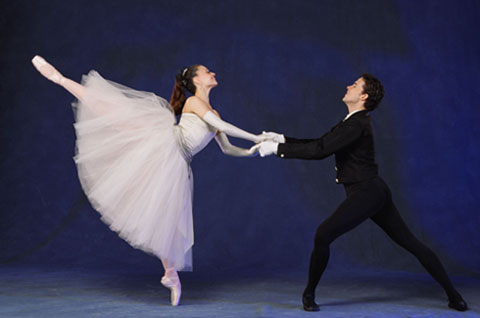
Jennifer Kronenberg and Carlos Guerra of Miami City Ballet in Balanchine’s La Valse. Photo by Joe Gato.
At Miami City Ballet’s opening night at New York City Center–the company’s long-awaited Manhattan debut–the curtain rose on a bevy of gorgeous, long-limbed young women in rakish pony tails and plain white leotards, reaching into space in a diagonal line that stretched cross-stage. The line then undulated, wave-like, in perfect formation, as if an electric impulse were coursing through it. This striking image, from Balanchine’s Symphony in Three Movements made the choreography look born again.
The full article appeared in Voice of Dance (http://www.voiceofdance.org) on January 30, 2009. To read it, click here.
School of American Ballet Celebrates 75th Anniversary
New York City Ballet: School of American Ballet 75th Anniversary Tribute / David H. Koch Theater / Lincoln Center, New York City / January 14, 2009
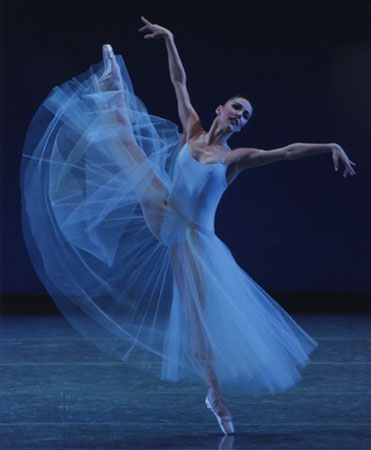
Patricia Delgado in Balanchine’s Serenade. Photo by Paul Kolnik.
I remember a time when it was informally called “The School,” as if the School of American Ballet, founded by George Balanchine and Lincoln Kirstein as the breeding ground for what would become the New York City Ballet, were the only teaching institution in America guaranteed to produce top-notch classical dancers. This was not the case even back then and it is certainly not the case now, but SAB is still the only American academy ranked with the schools of St. Petersburg’s Kirov Ballet (Balanchine’s alma mater), Moscow’s Bolshoi Ballet, and the Paris Opera Ballet.
The full article appeared in Voice of Dance (http://www.voiceofdance.org) on January 22, 2009. To read it, click here.
‘New Combinations’ Takes City Ballet to ‘Life’ Class
This article originally appeared in the Culture section of Bloomberg News on January 26, 2009.
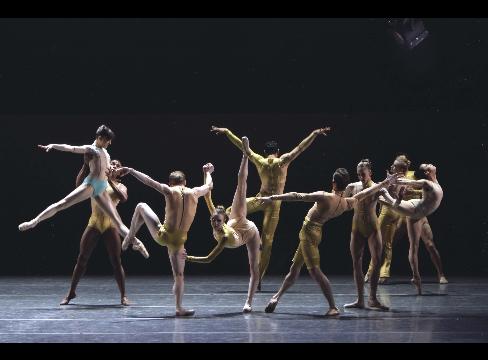
New York City Ballet dancers take part in a performance of “Lifecasting” in New York in this undated handout photo. Performances continue through March 1 at Lincoln Center’s David H. Koch Theater. Photographer: Paul Kolnik/NYCB via Bloomberg News
Jan. 26 (Bloomberg) — For George Balanchine’s birthday last Thursday at Lincoln Center’s David H. Koch Theater, the New York City Ballet premiered Douglas Lee’s “Lifecasting,” a dark yet strangely emotionless fantasy.
It was part of the company’s annual New Combinations evening, intended as a tribute to the master, who died in 1983. The tone of the piece is grave; the choreography, weightily somber. Yet it made me think, irreverently, of a child’s dream about classical statues in a museum coming to life when no one’s looking.
“There are no new steps, only new combinations,” Balanchine once declared. Peter Martins borrowed from this when he initiated the project, which has turned out to be a mixed blessing as gifts go. Usually it results in ballets less than wonderful, by choreographers trying too hard to look like the latest on the cutting edge.
One expects more persuasive results from Lee. Born in England, he trained at the Royal Ballet School, is now a principal dancer with the Stuttgart Ballet, and has participated in City Ballet’s New York Choreographic Institute. Yet, as we see time and again, pedigree alone doesn’t do the trick.
Set to music by Ryoji Ikeda and Steve Reich (not so odd a couple as you might think), “Life Casting” takes its title from the sculptor’s process of making casts directly from the human body. We see a bevy of dancers in a generically stark, handsome set, clad by Ines Alda in pale leotards suggesting plaster. Dancers are routinely considered a life force, but these are often eerily still or at least rooted to one spot, one of them always lying supine, as if laid out in death.
No Human Emotion
Matters eventually get somewhat livelier — bodies group themselves variously, small ones form to manipulate a single pliant figure — yet obdurately refuse to project any human feeling or purpose.
I enjoyed the movement Lee contrived, encompassing both the sinuous and the angular, but I remain baffled by what the choreographer expected his audience to make of it. The standouts in the cast were Robert Fairchild, Kaitlyn Gilliland and
Maria Kowroski.
This year’s New Combinations is subtitled “A Tribute to Nureyev,” in recognition of the Rudolf Nureyev Dance Foundation, which initiated a program of ongoing support for so-called emerging choreographers to work with the company. Unfortunately one of this year’s planned new works, by the Russian Alexey Miroshnichenko, had to be postponed until 2010.
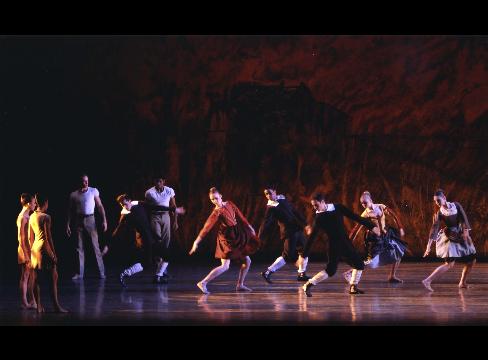
New York City Ballet dancers take part in a performance of “La Stravaganza” in New York in this undated handout photo. Performances continue through March 1 at Lincoln Center’s David H. Koch Theater. Photographer: Paul Kolnik/NYCB via Bloomberg News
The program was fleshed out with the pas de deux from August Bournonville’s charmingly flirtatious “The Flower Festival at Genzano,” Angelin Preljocaj’s incomprehensible “La Stravaganza,” the poignant pas de deux from Christopher Wheeldon’s “After the Rain,” and Balanchine’s “Theme and Variations,” evoking the brilliant grandeur of the Maryinsky tradition in its heyday.
Wouldn’t you know that, of these, the oldest, “Flower Festival” (1858) and “Theme” (1947), boasted the best choreography. You can usually, though not always, trust generations of viewers to know what’s worthy of an ongoing life.
The balletomanes in the audience succumb to Bournonville’s intricate steps; the rest of the crowd, to the charm the piece exudes. And surely everyone watching “Theme” these days can use a dose of palatial elegance.
Through March 1 at Lincoln Center, Broadway at 65th St. Information: +1-212-721-6500; http://www.nycballet.org.
© 2009 Bloomberg L.P. All rights reserved. Reprinted with permission.
Pink: Personal Indulgences No. 12
A young girl of my intimate acquaintance, let’s call her Eve, decided at the age of three or so that, when she grew up, she was going to be a boy.
She liked to play pretend games. You may remember them from your own childhood–those acted-out narratives, full of exciting incident, that have an endless life, with plots and characters repeating variations on a few themes presumably of deep significance to the players. In her “pertends,” as Eve called them, she invariably assigned herself the role of a man or boy. She was Joe. She was Nick. She was Doug. When I was her abettor–being a great fantasist myself, how could I not indulge her excursions to imagined worlds?–it took me a while to convince her that I like being a girl and so sometimes wanted to play a girl role. But Eve is a generous, tolerant soul and eventually let me be Helen or Jane.
Her kindergarten friends were nearly all boys. On her long, swift Atalanta legs, she ran around the playground with “the guys” in wild games of tag. With her pale coloring, slender build, and unconscious grace, she resembled a Victorian illustrator’s idea of a fairy. She concealed her rippling cornsilk hair firmly under a baseball cap until she persuaded her parents to let her cut it short, then shorter. In truth, she still didn’t look like a boy. She looked like Peter Pan.
But I believed in Eve’s earnestness in becoming a boy. I was convinced by an outing with her and her elder sister to a Chinatown emporium that sells thousands of things you didn’t know you needed. There we discovered a cache of tiny old-fashioned advertising cards. Flimsy bits of paper smaller than a Metro card, most of them pictured sentimentally lovely Asian women of the 1920s or 30s. A few, instead, showed exotically uniformed warriors of yore poised for battle. About 300 cards lay in a small wicker basket. Ten for a dollar. I told the girls they could each choose ten. Methodically, they examined each and every card. Eve’s sister found them irresistible and had trouble limiting her choices to ten. Eve found only two she wanted. The guys with the spears, of course.
Oddly enough, Eve’s passion to be a member of the opposite sex peaked with a seemingly trifling symptom: a hatred of pink. The color was anathema to her. She noticed it constantly–on people, in shop displays–greeting it with noises of disgust. Her sister would join in with relish, pointing out a gossamer blush-tinted bridesmaid’s gown displayed in the window of a tailor’s shop, and declare, “Now there’s something for you, Eve,” and the two would produce a racket of “Euew! Gross!” between attention-getting giggles.
After a while, however, Eve, gifted for art as well as baseball, found that she had no objection to using pink in her paintings. It was now offensive only in clothing. Since she bought all her clothes in the boys’ department, she was not often threatened by rosy hues. I did enjoy pointing out to her one day a twenty-something person of the male persuasion sporting a t-shirt that declared, full-frontally, “REAL MEN WEAR PINK.”
These days, now approaching the end of first grade and her second season as a Little Leaguer, Eve is softening on many fronts. She’s thought it through carefully, it would seem, and decided she is a girl and that that condition is fairly permanent–a given, really. Lately she’s even been planning names for her children. The roster of offspring, apparently, will include representatives of both genders. So Joe and Jane have a chance of being born into real life, as Eve scrupulously defines the opposite of her “pertends.” Still, the prospect of becoming a mother takes second place in her imagination to another deeply felt plan for her future. She intends to be a writer. I haven’t the heart to dissuade her. Yet.
© 2009 Tobi Tobias
Gloomy Cedar Lakers Leap Into Silly Stratosphere
This article originally appeared in the Culture section of Bloomberg News on January 9, 2009.
Jan. 9 (Bloomberg) — What can money buy? Cedar Lake Contemporary Ballet offers its 15 dancers most poverty-stricken artists’ dream: steady employment and health insurance, a rare luxury for American artists.
The trendy young company is performing through Jan. 18 at its own theater in Manhattan’s Chelsea district. Wal-Mart heiress Nancy Laurie, whose wealth makes the group possible, and Benoit- Swan Pouffer, its artistic director, are building a repertory dominated by foreign choreographers that lends the company an avant-garde air. In truth, Western concert dance has gone global, but audiences still enjoy the myth of exotica.
The dancers, who range from good to very good, are set in motion more in the vein of postmodern dance than classical ballet, though ballet training contributes to their virtuosity. The choreography is mainly dreadful — pretentious and often unfathomable. Typically, it bombards the stage with ferocious non-stop action, athletically and sometimes erotically charged, unrelieved by contrasting repose other than a glum catatonia. What ever happened to delight?
‘memory/measure’
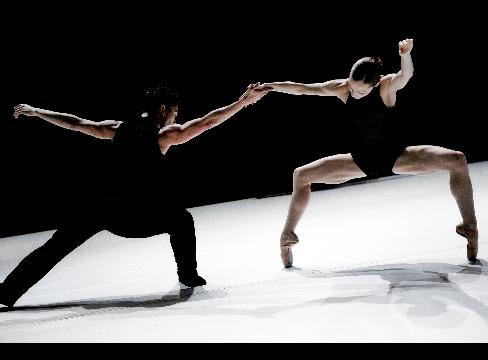
Dancers Jon Bond, left, and Acacia Schachte take part in the Cedar Lake Contemporary Ballet performance “memory/measure” by Luca Veggetti in New York on Dec. 13, 2008. The company is performing through Jan. 18, 2009 at its own theater in Manhattan’s Chelsea district. Photographer: Julieta Cervantes/Cedar Lake Contemporary Ballet via Bloomberg News
One of the two world premieres on the program fulfills this description perfectly. The Italian Luca Veggetti’s “memory/measure,” scored for voice and electronic cacophony by Paolo Aralla, places two couples in funereal black practice clothes on a chalk-white floor cloth and has them illustrate alienation. Their isolation, despite moments of physical contact, neither holds nor projects emotion. They accept their doom without comment, like citizens of a country subject to perennially gray weather. The action of the piece goes nowhere, as if feeling, or even the passage of time, didn’t exist.
Maybe someone whispered in Nancy’s or Benoit-Swan’s ear, “Lighten up.” The second world premiere on this season’s program, Didy Veldman’s “frame of view,” moves from the usual grim postmodern news Cedar Lake delivers to tame attempts at silliness. The juxtaposition is confusing and becomes increasingly so as the piece goes on and on and on.
It has a terrific set, by Miriam Buether, that uses frames to create the illusion of translucent black walls punctuated by three solid doors that suggest French bedroom farce. But no such luck: A couple making out on opposite sides of a stretch panel in one of the doors is less amusing than faux-surreal.
The denizens of Cedar Lake are not destined for frivolous gaiety. A fellow hides behind a door, presumably to his home, besieged by a bunch of light-hearted confetti-tossing celebrants, refusing to admit them to a party to which he’s presumably invited them. A moment later, still in his living room, he’s sprinkling his own tiny showers of confetti at a gargoylish man who’s captured a terrified maiden.
This piece doesn’t know its own mind and is far too long. The finale is the last straw. The dancers parade around the perimeters of the set as a litany of their fears is heard on tape.
My favorite: “I’m afraid of dancing.”
Through Jan. 18 at the Cedar Lake Theater, 547 W. 26th St. Information: +1-212-868-4444; http://www.cedarlakedance.com.
© 2009 Bloomberg L.P. All rights reserved. Reprinted with permission.
Oprah Joins Jamison, Ailey Dancers in 50th Season
This article originally appeared in the Culture section of Bloomberg News on December 5, 2008.
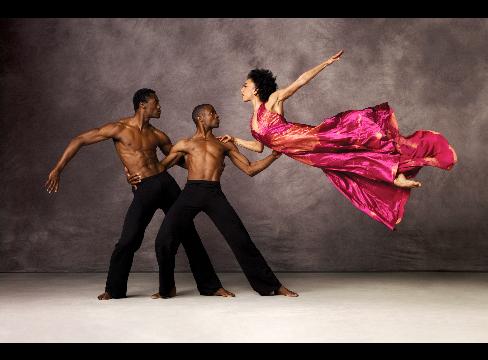
Alvin Ailey American Dance Theater’s Jamar Roberts, left; Amos J. Machanic, Jr., center; and Olivia Bowman rehearse in this photo taken on May 9, 2007. Photographer: Andrew Eccles/Alvin Ailey American Dance Theater via Bloomberg News
Dec. 5 (Bloomberg) — The Alvin Ailey American Dance Theater scorns doing things by half measures. Wednesday night’s gala opening of its five-week season at the City Center, celebrating its 50th anniversary, pulled out all the stops. What other dance company commands celebrities like Oprah Winfrey and divas like Jessye Norman to play a supporting role in what is often called “the orphan art”?
Judith Jamison, the company’s director, is a dazzling personality in her own right. Her speeches from the stage veered effortlessly from blithe humor to impassioned gravity. Winfrey’s tribute was forceful and compelling. And the first-night audience, fabulously dressed for festivity, matched the onstage performance with an ogle-worthy fashion show at intermission.
By the way, there was some dancing. After a lively, concise film on the company’s history, Ailey School students represented the rising generation in “Echoes of Alvin,” choreographed for the occasion by former company dancer Christopher Huggins. Then the lovely Donna Wood, an unforgettable Ailey alumna, emceed five Ailey excerpts performed by the main company.
The evening closed with the choreographer’s signature work, the 1960 “Revelations,” which, as always, stirred the audience to a fever pitch. All the superb solo singers of the spirituals stood onstage with the dancers instead of being seated in the pit.
Diva Distraction
The effect distracted somewhat from the dancing (especially in the incomparable rendition of the “Fix Me, Jesus” duet by Linda Celeste Sims and Glenn Allen Sims), but in the case of Jessye Norman, one can’t really complain.
After the customary encore of the closing few minutes of “Revelations,” the dancers reverently laid the sheaves of white roses they received during the curtain calls on the floor beneath a giant photo portrait of Ailey and left the stage. As the audience departed, the curtain remained raised, the dancing space gently illuminated like a shrine.
The season will feature lots of the company’s most striking works, a full week of programs devoted to choreography set to Duke Ellington music, performed live by the Jazz at Lincoln Center Orchestra with Wynton Marsalis, and two new pieces.
Ailey dancer Hope Boykin, who moves with a primal passion, has also begun a choreographic career. For her “Go in Grace,” she’s collaborated with the all-female vocal group Sweet Honey in the Rock, whose members will be mingled with the dancers.
The Italian choreographer Mauro Bigonzetti, who has sparked considerable interest in the U.S., will contribute “Festa Barocca,” set to a Handel score and blending classical and modern-dance techniques, an Ailey specialty.
Ailey’s Half-Century
The Ailey company’s importance lies as much offstage as it does in the pyrotechnical and emotional feats his dancers routinely achieve.
Its founding a half-century ago was the familiar shoestring venture, but one with a unique goal: creating a company mainly of black dancers, who were, shamefully, often excluded from the field.
In recent years, superb management has achieved goals ranging from steady employment for the dancers to the building of a $56 million mid-Manhattan complex that houses the main company, a junior troupe (Ailey II) and the Ailey school.
Over the years, members of the company have received just about every major dance award. A charismatic ambassador for its art, the Ailey has crisscrossed the globe, performing all over the U.S. and Asia and in European temples of classical culture like the Paris Opera and St. Petersburg’s Maryinsky Theater.
Jamison plans to retire in 2011. It’s hard to imagine who might replace her until you realize she succeeded Ailey and, instead of things falling apart, had the Empire State Building glowing gold last night in the company’s honor.
Through Jan. 4 at 131 W. 55th St. Information: +1-212-581- 1212; http://www.alvinailey.org.
© 2008 Bloomberg L.P. All rights reserved. Reprinted with permission.
Balanchine Casts Christmas Spell With ‘Nutcracker’
This article originally appeared in the Culture section of Bloomberg News on December 1, 2008.
Dec. 1 (Bloomberg) — It’s too easy to yield to the magic of George Balanchine’s “The Nutcracker,” performed by the New York City Ballet. It’s harder to define that enchantment.
Is it the Christmas tree that grows to a height of 40 feet before our eyes? Maybe it’s the skill and verve of the School of American Ballet kids who hold their own against the professionals. Perhaps it’s the female corps de ballet, each member a beauty in her own right, dancing in unison as snowflakes or flowers. Could it be the radiance and virtuosity of the principals?
The production, which opened Friday at the David H. Koch (formerly New York State) Theater for its annual five-week run, offers such pleasures. It amazes with old-fashioned theatrical marvels, enhanced by modern-day technology and the phenomenal technique of today’s classical ballet dancers, bred to their trade from a young age. Yet, the ballet’s real draw is its spirit.
Partnered with Tchaikovsky’s celestial score, Balanchine’s “Nutcracker” illuminates the idea that, whatever our real-life circumstances, extravagant dreams will abide in our lives.
The story, derived from E.T.A. Hoffmann’s tale, is set in motion by the inventor Herr Drosselmeier. The eccentric old man leads his goddaughter (the pre-pubescent Marie) and his young nephew (who morphs from nutcracker to budding prince) out of the predictable comforts of upper-middle-class life into the Land of Sweets. This imaginary kingdom is one of unadulterated delight, though to approach it the children must overcome fear and life- threatening danger — in the form of giant, menacing mice.
Drosselmeier Poetry
Robert La Fosse emphasized the poetry of Drosselmeier, while not forgetting the darker, subconscious motives that underlie his magic. As usual, the children under his spell were scrupulously rehearsed with no loss of spontaneous vitality.

Sara Mearns plays the part of The Sugarplum Fairy in the New York City Ballet production of “The Nutcracker” in New York in this undated handout photo. Photographer: Paul Kolnik/NYCB via Bloomberg News
The women taking the soloist roles were predictably good, but Sara Mearns, as the Sugarplum Fairy, regent of this delectable realm, went far beyond that, offering a passage of dancing in the duet at the ballet’s climax that was sublime. From her long, languorous stretches though the air to her feline leap from a distance onto her cavalier’s shoulder without a trace of preparation, her usual plush dancing was suffused with something indefinable yet ever-present — the secrets of the soul, perhaps.
In the weeks to come, the casting will vary in the many principal and soloist roles, with the company wisely treating “The Nutcracker” both as a showcase for the veterans and a proving ground for potential stars.
Tomasson’s ‘Nutcracker’
A serviceable alternative “Nutcracker” for audiences far from New York or who are watching their budget these days is San Francisco Ballet’s newest version, created in 2004 by the company’s artistic director, Helgi Tomasson.
It will be telecast on Dec. 17 in PBS’s “Great Performances” series and is available on DVD from Opus Arte.
To make his production unique, Tomasson uses a slideshow of vintage photos to set it in early 20th-century San Francisco with side trips to the later Victorian era. The second act, traditionally composed of individual dances evoking lands exotic to Americans, is tied to an ambitious 1915 exposition in the city that emphasized getting to know far-flung cultures.
The main trouble with the production lies in the concept of the young heroine, Clara (as she’s called here). The lovely Elizabeth Powell, a ballet student who dances with impeccable grace, is simply too old for this role, too far along in the decorum classical dance training imposes on a docile pupil, with no recourse but to utilize every pretty ballet mannerism in the book. While, on one hand, she lacks the exuberance of a child, on the other, whirling in the arms of the adult Nutcracker Prince as if she were his love interest, her character seems to have forgotten warnings her mother surely gave her about older men.
Athletic
True, it’s hard to resist Davit Karapetyan, a handsome fellow who has the uncanny ability to be simultaneously liquid and athletic in his movement.
The ominous mystery that lends the ballet the perilous dimension that makes it irresistible is absent. The life-size mechanical dolls Drosselmeier brings to the Christmas Eve party are suitable “Coppelia”-esque creations, but Damian Smith, playing their inventor, exudes none of the dark magic that usually inhabits those who fashion such wonders.
Apart from Drosselmeier, the character roles are beautifully done. Clara’s parents are utterly believable — mature, romantic, and good hosts. Even better are a grandmother with terrific elan and a slightly dotty grandfather, leading a social dance for three generations. The Mouse King, with his rapacious teeth and claws, is both comic and frightening.
Resplendent Costumes
The faux-exotic divertissements that constitute the second act, viewed by Drosselmeier and Marie — so Karapetyan, inarguably the star of this show, can disappear to find a more age- appropriate ballerina for the duet — are luscious, thanks to Martin Pakledinaz’s resplendent costumes.
The smooth, adroit dancing from adults and kids alike is a tribute to the training Tomasson has instilled in the company and its school. Yes, this production lacks logical coherence and psychological depth, but there’s enough eye-candy here to seduce all but the most exacting viewer who insists that a ballet should pierce the heart.
New York City Ballet will perform “The Nutcracker” at the David H. Koch Theater, Lincoln Center, NYC, through Jan. 3. Information: +1-212-721-6500 or http://www.nycballet.org. San Francisco Ballet’s “The Nutcracker” will air on PBS’s Great Performances Dec. 17 and is available as an Opus Arte DVD. Information: http://www.sfballet.org/nutcracker.
© 2008 Bloomberg L.P. All rights reserved. Reprinted with permission.
Thoughts on Balanchine’s “Nutcracker”
New York City Ballet: The Nutcracker / New York State Theater, NYC / November 28, 2008 – January 3, 2009
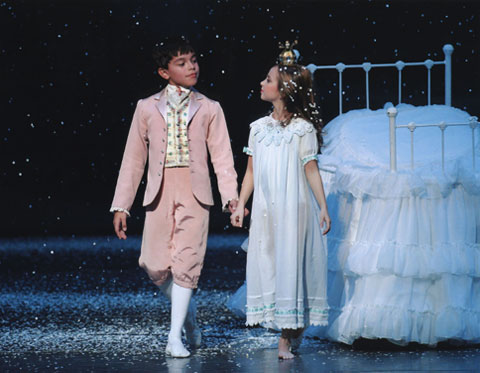
Marie awakens to witness startling transformations. The Christmas tree grows to gargantuan size. The toy soldiers, neatly arranged in a case in the drawing room grow to her own height and come to life to battle the mice. The bed that Drosselmeier’s nephew earlier offered Marie for her broken Nutcracker magically scoots away as if of its own volition to be replaced by a life-size bed, and the Nutcracker, now grown as well, charges into battle to protect the terrified Marie. The changes of size and awakening to new powers hint at the physical and emotional processes of puberty, during which a child can seem to grow in body and soul overnight.
The full article appeared in Voice of Dance (http://www.voiceofdance.org) on November 26, 2008. To read it, click here.
Richardson Brings Eye Candy, Grace to Complexions
This article originally appeared in the Culture section of Bloomberg News on November 21, 2008.
Nov. 21 (Bloomberg) — The multiethnic, multicultural Complexions Contemporary Ballet, which opened its two-week season at New York’s Joyce Theater on Tuesday, is devastatingly handsome and just as slick.
Founded in 1994 by former Alvin Ailey stars Dwight Rhoden and Desmond Richardson, the company is unlikely to change your life or lend you piercing insight into others’ lives. So many sophisticated dance fans give it a pass (as they do several other highly popular troupes, such as Pilobolus Dance Theater).
However, Richardson, the company’s leading man, is a real artist. Thought of as a modern dancer, he’s comfortable with classical ballet as well.

Desmond Richardson, the star and co-founder of Complexions Contemporary Ballet, rehearses in the studio on Aug. 30, 2008. The troupe opened its two week season at New York’s Joyce theater and will perform through Nov. 30. Photographer: Dah-len/Complexions Contemporary Ballet via Bloomberg News
Richardson’s dancing has subtle qualities, including infinitely varied texture and the ability to animate the space he inhabits like a piece of moving sculpture. He also manages to convey authentic emotion through even the slightest choreographic scripts. So there’s more to him than meets the eye, though it must be admitted he’s also a hunk: tall, long-limbed, and exquisitely proportioned, with musculature to die for and lines whose default mode is perfect harmony.
A highlight of the current season is “I Will Not Be Broken,” an extended solo with unusual accompaniment that Rhoden, the group’s chief choreographer, created for Richardson, his muse. It’s about surviving — triumphing, even — after one has hit bottom. Dramatically matched by Negro spirituals spoken and sung by actress S. Epatha Merkerson, it’s also augmented by a duet for two other dancers who seem to be figments of Rhoden’s memory.
Electrifying Presence
Rhoden writhes on and around a narrow wooden bench, making agonized gestures of pain, then eventually rises, reaching to the heavens, as if to reclaim his faith and, thus, his own salvation. Merkerson’s self-contained yet still electrifying presence as she moves among the dancers makes the piece a theatrical event as much as a choreographic one.
The only other worthy piece on the program was Igal Perry’s new “Constructs for 4,” a graceful and gracious quartet for a woman and three men. It provides a softness, fluidity, and musical phrasing that Rhoden’s choreography desperately lacks and some interesting passages of male-male partnering when the group work splinters into a double duet.
Velvety Touch
What made “Constructs” memorable and not simply pleasant was the dancing of Gary W. Jeter II, who might be a young clone of the mature Richardson. Perry gave him a long solo that contrasted difficult ballet steps, such as double turns in the air, with modern dance’s melting falls to the floor, all of which Jeter executed with a velvety touch and modest manner. The company is blessed to have him.
Opening night also featured two over-long, over-populated pieces by Rhoden — “Routines” and “Rise” — and a brief one, “Ave Maria.” The last was simply vulgar.
The first two revealed Rhoden’s weaknesses to an embarrassing degree. He arranges his dancers in simple geometric patterns that are cumulatively stultifying.
He has them move continuously with aggressive force as if at war with the world, even when, as in “Rise,” encouraged by the music of U2, they’re presumably ecstatic with the joy of life. He seems ignorant of the nature of flesh, with its sensuous pliancy. This alone, in a choreographer, is very bad news.
Through Nov. 30 at 175 Eighth Ave. Information: +1-212-242- 0800; http://www.joyce.org.
© 2008 Bloomberg L.P. All rights reserved. Reprinted with permission.
What Ever Happened to Bebe Miller?
Bebe Miller Company: Necessary Beauties / Dance Theater Workshop, NYC / November 11-15, 2008
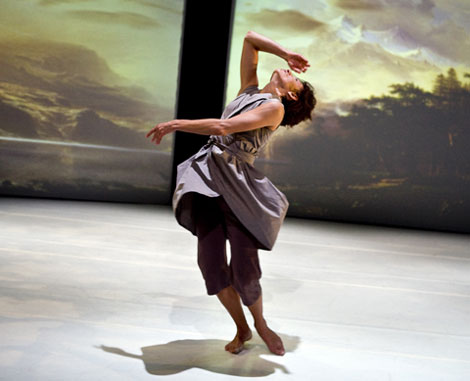
I remember the veteran dancer-choreographer Bebe Miller for two qualities: the ferocity of her performing–she was a wild, thrillingly unpredictable woman when she was dancing–and, later, for the choreography of a couple of pieces I saw that, with understanding and tenderness, focused on the humane aspects of the human race.
The full article appeared in Voice of Dance (http://www.voiceofdance.org) on November 13, 2008. To read it, click here.



